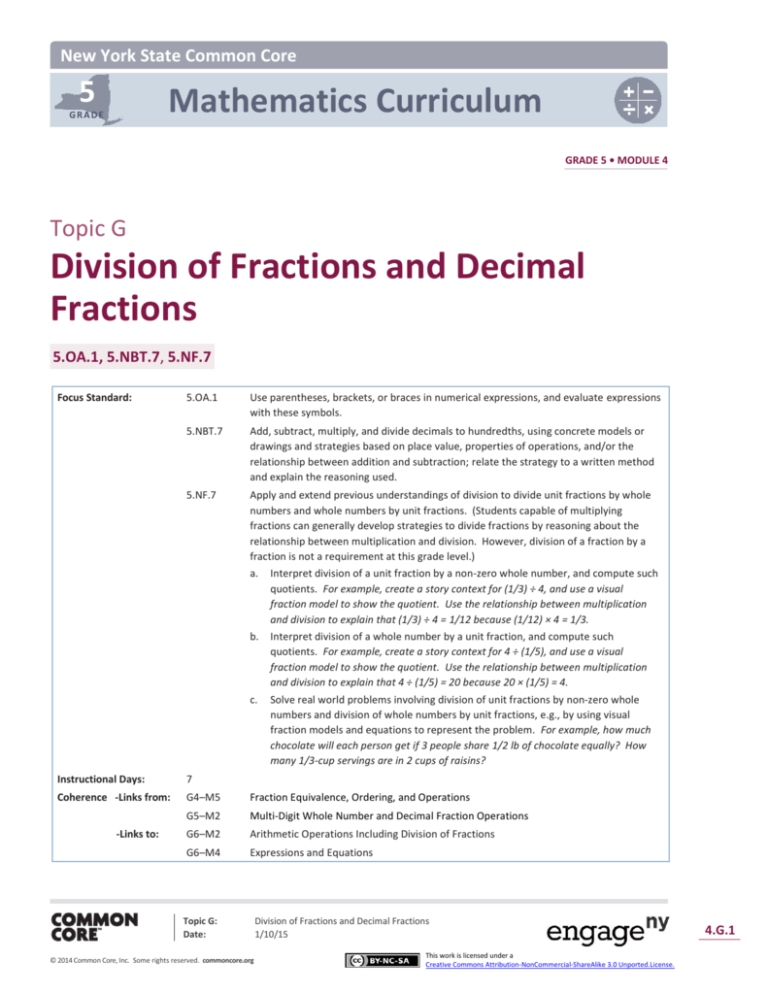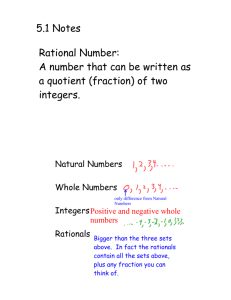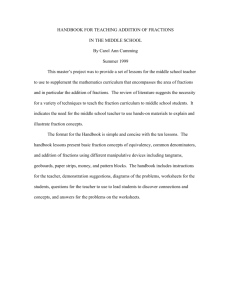
New York State Common Core
5
Mathematics Curriculum
GRADE
GRADE 5 • MODULE 4
Topic G
Division of Fractions and Decimal
Fractions
5.OA.1, 5.NBT.7, 5.NF.7
Focus Standard:
5.OA.1
Use parentheses, brackets, or braces in numerical expressions, and evaluate expressions
with these symbols.
5.NBT.7
Add, subtract, multiply, and divide decimals to hundredths, using concrete models or
drawings and strategies based on place value, properties of operations, and/or the
relationship between addition and subtraction; relate the strategy to a written method
and explain the reasoning used.
5.NF.7
Apply and extend previous understandings of division to divide unit fractions by whole
numbers and whole numbers by unit fractions. (Students capable of multiplying
fractions can generally develop strategies to divide fractions by reasoning about the
relationship between multiplication and division. However, division of a fraction by a
fraction is not a requirement at this grade level.)
a.
Interpret division of a unit fraction by a non-zero whole number, and compute such
quotients. For example, create a story context for (1/3) ÷ 4, and use a visual
fraction model to show the quotient. Use the relationship between multiplication
and division to explain that (1/3) ÷ 4 = 1/12 because (1/12) × 4 = 1/3.
b.
Interpret division of a whole number by a unit fraction, and compute such
quotients. For example, create a story context for 4 ÷ (1/5), and use a visual
fraction model to show the quotient. Use the relationship between multiplication
and division to explain that 4 ÷ (1/5) = 20 because 20 × (1/5) = 4.
c.
Solve real world problems involving division of unit fractions by non‐zero whole
numbers and division of whole numbers by unit fractions, e.g., by using visual
fraction models and equations to represent the problem. For example, how much
chocolate will each person get if 3 people share 1/2 lb of chocolate equally? How
many 1/3-cup servings are in 2 cups of raisins?
Instructional Days:
7
Coherence -Links from:
G4–M5
Fraction Equivalence, Ordering, and Operations
G5–M2
Multi-Digit Whole Number and Decimal Fraction Operations
G6–M2
Arithmetic Operations Including Division of Fractions
G6–M4
Expressions and Equations
-Links to:
Topic G:
Date:
© 2014 Common Core, Inc. Some rights reserved. commoncore.org
Division of Fractions and Decimal Fractions
1/10/15
This work is licensed under a
Creative Commons Attribution-NonCommercial-ShareAlike 3.0 Unported.License.
4.G.1
Topic G 5
NYS COMMON CORE MATHEMATICS CURRICULUM
Topic G begins the work of division with fractions—both fractions and decimal fractions. Students use tape
diagrams and number lines to reason about the division of a whole number by a unit fraction and a unit
fraction by a whole number (5.NF.7). Using the same thinking developed in Module 2 to divide whole
1
numbers, students reason about how many fourths are in 5 when considering cases such as 5 ÷ 4. They also
1
1
reason about the size of the unit when 4 is partitioned into 5 equal parts: 4 ÷ 5. Using this thinking as a
backdrop, students are introduced to decimal fraction divisors and use equivalent fraction and place value
thinking to reason about the size of quotients, calculate quotients, and sensibly place the decimal in quotients
(5.NBT.7).
A Teaching Sequence Toward Mastery of Division of Fractions and Decimal Fractions
Objective 1: Divide a whole number by a unit fraction.
(Lesson 25)
Objective 2: Divide a unit fraction by a whole number.
(Lesson 26)
Objective 3: Solve problems involving fraction division.
(Lesson 27)
Objective 4: Write equations and word problems corresponding to tape and number line diagrams.
(Lesson 28)
Objective 5: Connect division by a unit fraction to division by 1 tenth and 1 hundredth.
(Lesson 29)
Objective 6: Divide decimal dividends by non-unit decimal divisors.
(Lessons 30–31)
Topic G:
Date:
© 2014 Common Core, Inc. Some rights reserved. commoncore.org
Division of Fractions and Decimal Fractions
1/10/15
This work is licensed under a
Creative Commons Attribution-NonCommercial-ShareAlike 3.0 Unported.License.
4.G.2






